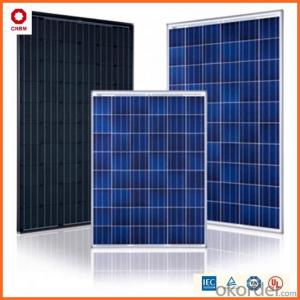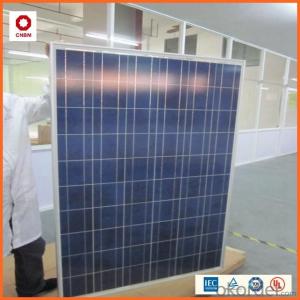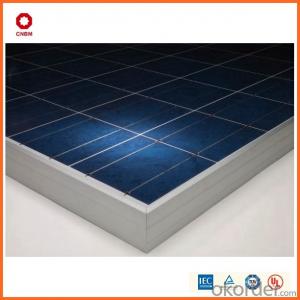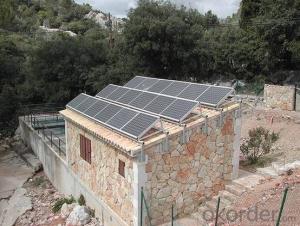70w Poly Small Solar Panels on Stock with Good Quality
- Loading Port:
- China main port
- Payment Terms:
- TT OR LC
- Min Order Qty:
- 1 watt
- Supply Capability:
- 10000000 watt/month
OKorder Service Pledge
OKorder Financial Service
You Might Also Like
Item specifice
Hot Sale !!! Quality and Safety of Small Poly Solar Panel 25~85w
1. Rigorous quality control meets the highest international standards.
2. High-transmissivity low-iron tempered glass, strong aluminium frame.
3. Using UV-resistant silicon.
4. IS09001/14001/CE/TUV/UL
Warranties of Small Poly Solar Panel 25~85w
1. 10 years limited product warranty
2. 15 years at 90% of the minimal rated power output
3. 25 years at 80% of the minimal rated power output
Specification
Characteristics of Poly solar panels CNBM (25-85W) | |||||
Max Power Voltage Vmp(V) | 30.3 | 30.8 | 31.1 | 31.4 | 31.85 |
Max Power Current Imp(A) | 7.60 | 7.64 | 7.73 | 7.81 | 7.85 |
Open Circuit Voltage Voc(V) | 36.1 | 36.6 | 37 | 37.3 | 37.68 |
Short Circuit Current Isc(A) | 8.50 | 8.55 | 8.65 | 8.75 | 8.85 |
Max Power Pm(W) | 230W | 235W | 240W | 245W | 250W |
Temperature Coefficient of Cells Poly solar panels CNBM (25-85W) | |
NOCT | 45± 2 |
Temperature Coeffucients of Isc | 0.0492 |
Temperature Coeffucients of Voc | -0.3374 |
Temperature Coeffucients of Voc | -0.4677 |
Mechanical Data of Poly solar panels CNBM (25-85W) | |
Dimension | 1638 × 982 × 40 mm |
Weight | 19.5 kg |
No. of Cells and Connections | 60 (6 ×10) |
Tolerance | 0 ~ + 5 W |
Cell | Monocrystalline Cell 156 × 156 mm |
Packing | 624 Pcs/40ft(H) Container |
Limits of Poly solar panels CNBM (25-85W) | |
Operating Temperature | -40 to +85 |
Storage Temperature | -40 to +85 |
Max System Voltage | 1000VDC(IEC) / 600VDC(UL) |
Features of our products:
• High conversion efficiency mono/poly-crystalline amorphous silicon solar cells
• Modules incorporate high performance bypass diodes to minimize the power drop caused by shading
• High transmittance, low-iron tempered glass
• High performance EVA encapsulant to prevent destroying and water.
• AI frame: without screw, corner connection. 8 holes on the frame can be installed easily
• Good performance of preventing from atrocious weather such as wind and hails
• Certifications: CE IEC TUV VDE UL, Class I
• 10 years 90% power output warranty

Shipping of Small Poly Solar Panel 25~85w
By Sea | Delivery from Shanghai or Ningbo seaport |
By Air | Departure from Shanghai Pudong Airport |
By Express | Post by DHL, EMS, UPS, TNT. |
- Q:Can solar energy systems be used for powering amusement parks or entertainment venues?
- Yes, solar energy systems can be used for powering amusement parks or entertainment venues. Solar power has emerged as a viable and sustainable alternative to traditional energy sources, providing numerous benefits for large-scale operations like amusement parks. Amusement parks and entertainment venues consume a significant amount of energy, especially during peak operating hours. By installing solar panels, these venues can generate clean and renewable energy on-site, reducing their dependence on fossil fuels and lowering their carbon footprint. This not only helps in combating climate change but also promotes environmental stewardship and sustainability. Solar energy systems can be designed to meet the specific energy needs of amusement parks. The expansive roofs of buildings, parking lots, and other open spaces can be utilized to install solar panels, maximizing the energy generation potential. Additionally, advancements in solar technology such as thin-film solar panels and solar canopies offer innovative solutions to integrate solar power seamlessly into the park's infrastructure. One of the key advantages of solar power is its ability to generate electricity during peak demand periods, which often align with the peak operating hours of amusement parks. This ensures a reliable and consistent power supply, preventing disruptions and ensuring a smooth and enjoyable experience for visitors. Furthermore, solar energy systems can also be coupled with battery storage solutions. Excess energy generated during the daytime can be stored in batteries and utilized during the evening or on cloudy days, ensuring uninterrupted power supply even when the sun is not shining. This enhances the reliability and resilience of the park's energy infrastructure. In addition to the environmental and operational benefits, solar energy systems can also provide cost savings in the long run. While the initial investment may be higher, the ongoing operational costs are significantly lower compared to traditional energy sources. The savings generated from reduced electricity bills can be reinvested into improving park infrastructure, enhancing visitor experiences, and expanding attractions. Amusement parks and entertainment venues have a unique opportunity to showcase their commitment to sustainability and renewable energy by adopting solar power systems. By harnessing the power of the sun, these venues can not only reduce their environmental impact but also inspire visitors to make more sustainable choices in their own lives. In conclusion, solar energy systems can indeed be utilized to power amusement parks and entertainment venues. The numerous benefits, including environmental sustainability, reliable power supply, cost savings, and the opportunity to promote renewable energy, make solar power an excellent choice for powering these large-scale operations.
- Q:How do solar energy systems impact energy policy and regulation?
- Solar energy systems have a significant impact on energy policy and regulation by promoting the adoption of renewable energy sources and reducing dependence on fossil fuels. Governments and regulatory bodies often implement policies and regulations that incentivize the installation and use of solar energy systems, such as feed-in tariffs or tax credits. This helps to accelerate the transition to clean energy and achieve sustainability goals. Additionally, solar energy systems can influence the development of grid infrastructure and energy storage technologies to accommodate the intermittent nature of solar power, leading to a more resilient and decentralized energy system.
- Q:Do solar energy systems require specialized insurance?
- Yes, solar energy systems typically require specialized insurance. This is because solar energy systems are a significant investment and can be vulnerable to various risks such as damage from natural disasters, theft, or system malfunctions. Standard homeowner's insurance policies may not provide adequate coverage for these risks, so it is advisable to obtain specialized insurance for solar energy systems. This insurance can cover the costs of repairs or replacements in the event of damage or loss and provide liability coverage in case of accidents or injuries related to the system. It is important to consult with insurance providers who specialize in renewable energy systems to ensure that the specific needs and risks associated with solar energy systems are properly addressed.
- Q:Can solar energy systems be used in areas with limited access to solar energy permits and approvals?
- Yes, solar energy systems can be used in areas with limited access to solar energy permits and approvals. While permits and approvals may be required in certain regions, there are often alternative solutions available. Off-grid solar systems, for example, can be installed in areas without needing permission from utility companies or government entities. Additionally, some areas may have simplified processes or incentives for renewable energy installations, making it easier to overcome permit limitations. It is important to consult local regulations and explore the available options to ensure compliance and maximize the use of solar energy in such areas.
- Q:Can solar energy be used in cloudy climates?
- Yes, solar energy can still be used in cloudy climates, although the efficiency may be reduced. Solar panels can still generate electricity even with limited sunlight, although the output will be lower compared to sunny conditions. Additionally, advancements in solar technology and the use of tracking systems can help optimize energy production in cloudy environments.
- Q:Can solar energy systems reduce electricity bills?
- Yes, solar energy systems can reduce electricity bills. By harnessing energy from the sun, these systems generate electricity that can power homes and businesses, significantly reducing reliance on traditional electricity sources. This can lead to substantial savings on monthly electricity bills, especially when combined with net metering or feed-in tariffs. Additionally, solar energy systems require minimal maintenance and have a lifespan of 25-30 years, making them a cost-effective long-term investment.
- Q:Can solar energy systems be used in areas with limited access to educational resources?
- Yes, solar energy systems can be used in areas with limited access to educational resources. Solar energy systems are relatively simple to install and operate, requiring minimal technical knowledge. With basic training and guidance, local communities can learn to set up and maintain solar systems, even in areas with limited educational resources. Additionally, there are numerous online resources and organizations that provide educational materials and support for individuals and communities interested in harnessing solar energy. Thus, solar energy systems can be a viable and sustainable solution for areas with limited access to educational resources.
- Q:What is the role of monitoring systems in a solar energy system?
- The role of monitoring systems in a solar energy system is to gather and analyze data related to the performance and efficiency of the system. These systems play a crucial role in ensuring that the solar energy system is functioning optimally, and any potential issues or inefficiencies are identified and addressed promptly. Monitoring systems typically include sensors and meters that measure various parameters such as solar radiation, energy production, temperature, and voltage. This data is collected in real-time and can be accessed remotely, allowing system owners, operators, and maintenance personnel to monitor the system's performance from anywhere. By collecting and analyzing this data, monitoring systems provide valuable insights into the overall health and functionality of the solar energy system. They can detect and alert users about any malfunctions, such as faulty panels, inverters, or wiring, enabling prompt maintenance or repairs. This proactive approach helps minimize downtime and maximize energy production, ensuring the system operates at its full potential. Furthermore, monitoring systems also help in optimizing the energy output of the solar system. By tracking energy production and consumption patterns, they can identify opportunities for improvement, such as adjusting the tilt or orientation of the panels, optimizing the battery storage, or even implementing energy-saving measures. These insights allow system owners to make informed decisions to enhance the overall efficiency and performance of the solar energy system. In addition to system performance tracking, monitoring systems also provide valuable financial and environmental benefits. They can calculate and display real-time energy production, enabling system owners to monitor their energy savings and financial returns. This information is crucial for assessing the system's payback period and determining the return on investment. Moreover, monitoring systems enable the identification of any inconsistencies or deviations from expected energy production, which can indicate potential issues such as shading or dirt accumulation on the panels. By addressing these issues promptly, system owners can maintain the system's efficiency, prolong its lifespan, and reduce maintenance costs. Overall, monitoring systems are an integral part of solar energy systems, providing real-time data and insights that help optimize performance, detect and address issues promptly, maximize energy production, and ensure a strong return on investment.
- Q:Can a solar energy system be installed on any type of roof?
- Yes, a solar energy system can be installed on any type of roof. Whether it is a flat roof, sloped roof, metal roof, shingle roof, or even a tile roof, there are solar installation options available for each type. However, the installation process may vary depending on the roof type. For example, flat roofs may require mounting systems that tilt the solar panels to optimize their exposure to the sun, while sloped roofs may require adjustable racking systems to ensure proper alignment. Additionally, the condition and structural integrity of the roof should be assessed before installation to ensure it can support the weight of the solar panels. Overall, while the specific installation methods may vary, solar energy systems can indeed be installed on any type of roof.
- Q:Can solar energy systems be used for powering electric train systems?
- Yes, solar energy systems can be used to power electric train systems. Solar energy can be converted into electricity using photovoltaic (PV) panels or concentrated solar power (CSP) systems. This electricity can then be used to power the traction motors of electric trains, eliminating the need for traditional fossil fuel-powered engines. The feasibility of using solar energy for train systems depends on various factors such as the availability of sunlight, the size and efficiency of the solar panels, and the energy requirements of the trains. For example, in regions with abundant sunlight, such as deserts, solar energy can be harnessed effectively to power train systems. There are already several successful examples of solar-powered train systems around the world. For instance, the Byron Bay Train in Australia is powered entirely by a solar train system, relying on a combination of solar panels and battery storage. In addition, a section of the railway line in India is powered by solar energy, providing clean and sustainable transportation. Implementing solar energy systems for powering electric trains can bring numerous benefits. First and foremost, it reduces the dependence on fossil fuels, decreasing greenhouse gas emissions and contributing to combating climate change. Solar energy is a renewable source, so it offers a sustainable and long-term solution for powering train systems. Moreover, solar-powered trains can help reduce operating costs as they require less maintenance and are not subject to fluctuating fuel prices. However, there are also some challenges associated with using solar energy for train systems. The initial installation cost of solar panels and related infrastructure can be high, although the long-term operational savings can outweigh this investment. Additionally, the intermittent nature of sunlight can pose a challenge, especially during cloudy or nighttime conditions. This can be addressed by utilizing battery storage systems, which store excess energy generated during peak sunlight hours and release it when needed. In conclusion, solar energy systems can indeed be used for powering electric train systems. With advancements in solar technology and the increasing need for sustainable transportation, solar-powered trains have the potential to play a significant role in the future of rail transportation, promoting clean energy and reducing environmental impacts.
1. Manufacturer Overview |
|
|---|---|
| Location | |
| Year Established | |
| Annual Output Value | |
| Main Markets | |
| Company Certifications | |
2. Manufacturer Certificates |
|
|---|---|
| a) Certification Name | |
| Range | |
| Reference | |
| Validity Period | |
3. Manufacturer Capability |
|
|---|---|
| a)Trade Capacity | |
| Nearest Port | |
| Export Percentage | |
| No.of Employees in Trade Department | |
| Language Spoken: | |
| b)Factory Information | |
| Factory Size: | |
| No. of Production Lines | |
| Contract Manufacturing | |
| Product Price Range | |
Send your message to us
70w Poly Small Solar Panels on Stock with Good Quality
- Loading Port:
- China main port
- Payment Terms:
- TT OR LC
- Min Order Qty:
- 1 watt
- Supply Capability:
- 10000000 watt/month
OKorder Service Pledge
OKorder Financial Service
Similar products
New products
Hot products
Hot Searches
Related keywords































